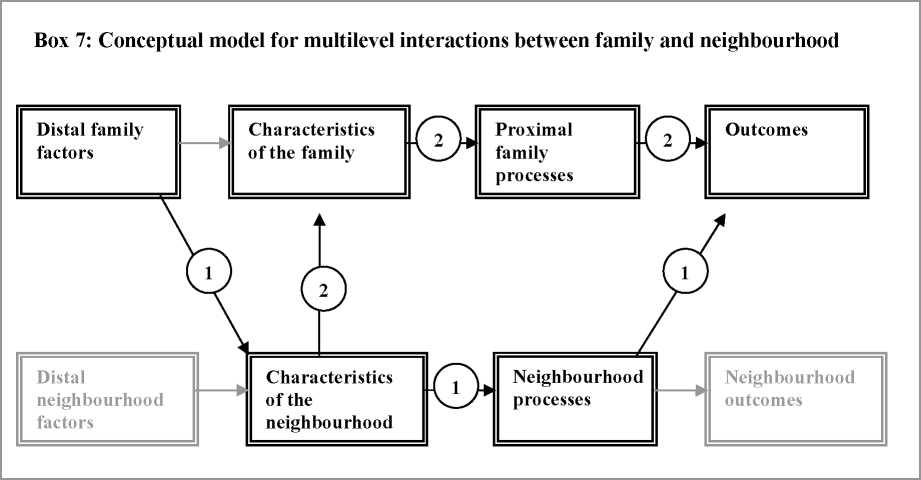The importance of context
example of neighbourhood. Key elements are illustrated in Box 7 below. Many other
inter-relationships might also be described but we focus on two. In Box 7 some
features are reproduced in grey in order to foreground the two aspects discussed.

First of all, we note that neighbourhood is a pathway for the effect of family-level
distal factors such as income (arrows 1). Family-level distal factors influence
neighbourhood-level (or other level) characteristics in the sense that richer families
choose leafier suburbs or more educated families choose neighbourhoods with more
successful schools. These neighbourhood characteristics in turn influence outcomes.
Secondly, we note that neighbourhood characteristics influence family characteristics
(arrows 2). The values and well-being of families are not immune to their wider
context. Thus, neighbourhood characteristics impact on family process and so on
child development through the family as well as through the extra-familial
relationships of children3.
Relationship between family and school contexts
To take another example, consider the interactions between family and school
contexts (Box 8). Distal family factors influence the characteristics of a given school
in a similar way as they do for neighbourhoods. More affluent families, for example,
are able to choose better resourced and more desirable schools and more educated
parents may be better equipped to assess quality and so choose the more successful,
higher achieving schools. These school characteristics, again, influence outcomes
through the mediating channel of school and teacher processes (arrows 1).
3 Neighbourhoods may also impact on our distal factors, though we do not pursue this here.
38
More intriguing information
1. Testing Hypotheses in an I(2) Model with Applications to the Persistent Long Swings in the Dmk/$ Rate2. Housing Market in Malaga: An Application of the Hedonic Methodology
3. Innovation in commercialization of pelagic fish: the example of "Srdela Snack" Franchise
4. The name is absent
5. Labour Market Flexibility and Regional Unemployment Rate Dynamics: Spain (1980-1995)
6. Healthy state, worried workers: North Carolina in the world economy
7. Optimal Vehicle Size, Haulage Length, and the Structure of Transport Costs
8. The name is absent
9. The name is absent
10. The name is absent